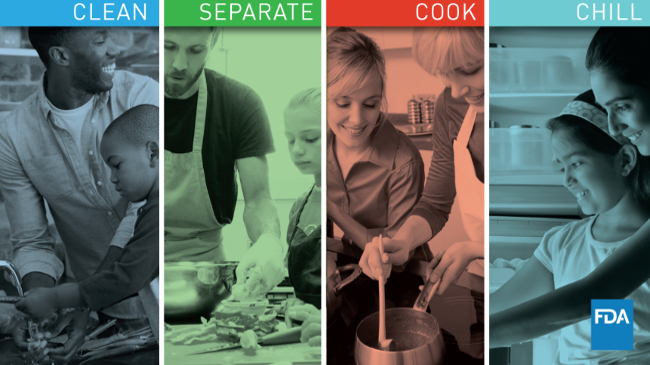September is Food Safety Education Month: Each week we will post educational material about food safety. Some is for consumers, some is for educators, all is targeted on reducing foodborne illness.
This month take an active role in preventing foodborne illness, also known as “food poisoning.” The federal government estimates that there are about 48 million cases of foodborne illness annually – that’s about 1 in 6 Americans each year. Each year, these illnesses result in an estimated 128,000 hospitalizations and 3,000 deaths. Following simple food safety tips can help lower your chance of getting sick.
National Food Safety Education Month Resources
FDA has resources to help encourage you and your community to put food safety first.
- Safe Food Handling – Follow these four key steps to food safety.
- Food Safety in Your Kitchen – Get tips for food safe shopping, storage, and meal prep.
- People at Risk of Foodborne Illness – Learn what groups are more at risk for foodborne illnesses.
- Food Safety for Pregnant Women – Find food safety information for before, during, and after pregnancy.
- Everyday Food Safety for Young Adults – Learn about food safety whether you’re cooking at home, dining out, or eating ready-made meals on the go.
- Education Resource Library – Find printable educational materials, videos, and more!
- Continuing Medical Education Program – Learn how to identify, treat, and report foodborne illness.
- Science and Our Food Supply – Bring food science into your middle and high school classrooms.
- Consumer Food Safety Educator Evaluation Toolbox and Guide – Get tips, tools, and examples to plan, develop, and evaluate food safety programs and activities.
Social Media Resources
Help us to spread the word about the importance of food safety. Use these Twitter and Facebook messages to show your support for Food Safety Education Month and to encourage your community to keep food safe.
Sample Tweets
Learning the do’s and don’ts of food-safe meal prep can help avoid foodborne illness. Start in the kitchen, putting #foodsafety into practice to protect you and your family. http://go.usa.gov/xV2YK #NFSEM
#CLEAN – Rinse fruits and veggies under running water. Slicing or dicing? Scrub ‘em anyway– germs can jump from rinds to the insides during cutting and peeling. https://go.usa.gov/xVT3t #NFSEM
#COOK – When you’re cooking you can’t tell if it done just by looking. Use a food thermometer to make sure it’s safe to eat. https://go.usa.gov/xVT3d #NFSEM
#SEPARATE – No yolking around! Storing eggs on the fridge door can expose them to uneven temperatures. Here’s where you should store them instead: https://go.usa.gov/xVT3G#NFSEM #FoodSafety
#CHILL – Keep your cool – especially when it comes to grocery, leftovers, & food delivery items. Your fridge should be 40 degrees F or less, the freezer zero degrees F or less. https://go.usa.gov/xVT3A#NFSEM
Sample Facebook Posts
Think food poisoning is just a little upset tummy and will pass? Not always. Sometimes foodborne illness is serious & even life threatening. We’ve got short video stories from 3 people that speak from experience! https://go.usa.gov/xV2ry National Food Safety Education Month
Looking for free food safety information? Whether a consumer, teacher of middle & high school students, or a food service worker, you’ve come to the right place! Check out our resource library to find free education materials, printable posters, and videos. https://go.usa.gov/xPCJENational Food Safety Education Month
Remember and follow these 4 key steps from @FDAfood to follow and keep your family safer from food poisoning
- Clean
- Separate
- Cook
- Chill
http://go.usa.gov/xV2YK #NFSEM
You wash apples, tomatoes and strawberries before you eat them, but what about cantaloupes, avocados and kiwi? https://go.usa.gov/xVT3t Hint: the answer is YES. #NFSEM
No yolking around! Storing eggs on the fridge door can expose them to uneven temperatures. Here’s where you should store them instead: https://go.usa.gov/xVT3G #NFSEM #FoodSafety
When you’re cooking you can’t tell if it done just by looking. Use a food thermometer to make sure it’s safe to eat. https://go.usa.gov/xVT3d #NFSEM
Keep your cool – especially when it comes to grocery, leftovers, & food delivery items. Your fridge should be 40°F or less, the freezer 0°F or less. https://go.usa.gov/xVT3A #NFSEM
Resources
Looking for #foodsafety information? Whether a consumer, teacher of middle and high school students, or a food service worker, you’ve come to the right place!
Check out @FDAfood’s resource library to find free printable materials and videos. https://go.usa.gov/xPCJE #NFSEM
(To sign up for a free subscription to Food Safety News, click here.)

